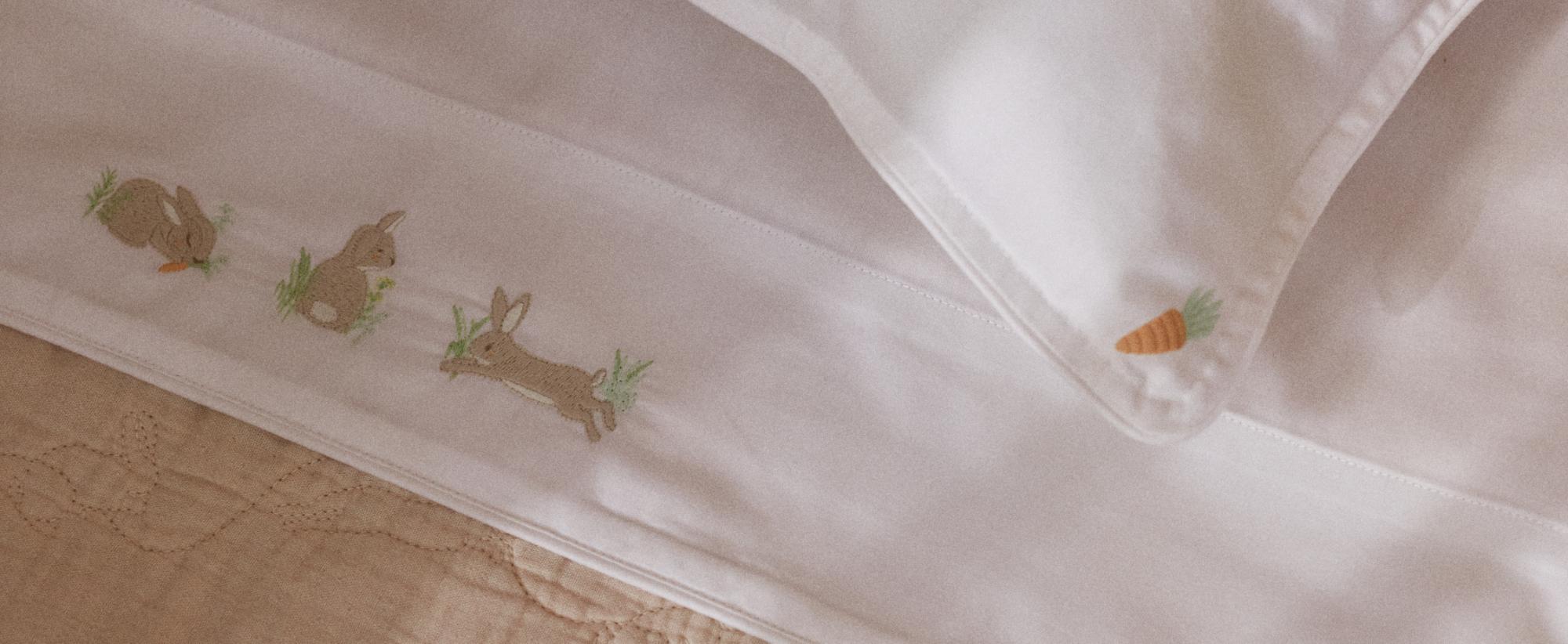
One of the first steps in creating a cosy and safe environment for your baby is choosing the right nursery bedding. High-quality materials such as organic cotton and hypoallergenic options ensure that your baby’s sensitive skin is protected, while the comfort provided by breathable fabrics promotes a restful and peaceful sleep. Additionally, choosing the right nursery bedding contributes to the harmony of the space, creating a refuge for your baby.
Nursery bedding refers to the various items that make up the baby’s sleeping area – whether a cot or bed – ensuring comfort and safety. Nursery bedding includes sheets, blankets, comforters, cot bumpers, mattress protectors, and sleeping bags. Choosing each of these items carefully ensures that your baby will sleep comfortably, without the risk of allergies or injury.
Sheets are the foundation of nursery bedding and are typically made from soft materials, like cotton, to avoid irritation on the baby’s delicate skin. Blankets and comforters provide an extra layer of warmth, and it’s important to choose lightweight and breathable options to prevent overheating and discomfort.
This issue of thermal imbalance is perfectly addressed with a sleeping bag, which keeps the baby at a consistent temperature throughout their sleep. Cot bumpers, although controversial, are often used to prevent the baby from bumping into or getting stuck between the cot bars.
Choosing the best nursery bedding involves considering several factors that ensure the baby’s safety and comfort. Let’s look at some key aspects:
Safety should be the number one priority when choosing nursery bedding. Ensure that the sheets fit snugly on the cot mattress to avoid them coming loose and posing a suffocation risk. Avoid using heavy blankets, and if you opt for cot bumpers, choose breathable and safe options.
Choose nursery bedding made from hypoallergenic and soft materials.
Organic cotton is an excellent option, as it is breathable, durable, and free from toxic chemicals that could affect the baby’s skin. Another good choice is bamboo, known for its antimicrobial properties.
As long as it doesn’t compromise functionality, design plays an important role in complementing the room’s décor and creating a harmonious environment.
Look for easy-care nursery bedding that can withstand frequent washing, ensuring that the cot is always clean and fresh.
There are various types of nursery bedding available, each with specific characteristics to meet your baby’s needs.
Nursery sheets are the foundation of any nursery bedding set. They should be made from soft and breathable materials and fit the mattress well. Sheets with elasticated edges are ideal as they stay in place even as the baby moves.
Blankets and comforters are versatile in that they can be used to keep the baby warm at home or during outings. However, it is important to choose lightweight options and avoid heavy blankets to reduce the risk of suffocation, especially during the baby’s early months.
Cot bumpers are often placed at the head of the cot to protect the baby from bumping into the bars. However, many safety experts recommend caution when using them due to suffocation risks. The safest option in this type of protection is to choose breathable bumpers.
Mattress protectors are an important part of nursery bedding as they protect the mattress from spills and accidents. The best options are waterproof covers that are easy to remove for washing.
There is a wide range of nursery bedding available, in both designs and themes, making it easy to personalise the baby’s space to suit any style.
For those who prefer a clean and timeless aesthetic, neutral and minimalist themes in shades of grey, beige, and white are an excellent choice. These designs are usually versatile and easily blend with other decorative elements.
If the goal is to create a vibrant and lively space, consider nursery bedding with colourful themes and fun patterns, such as animals, stars, or children's characters. In addition to brightening up the room, this style of design can stimulate the baby’s visual development.
To give the nursery bedding a special touch, consider personalising it with the baby’s name or a monogram. This is a great way to make the cot unique and personal.
Caring for nursery bedding properly is a way to maintain a healthy environment for the baby.
Wash nursery bedding regularly to ensure it is always clean and free from bacteria. Use mild, hypoallergenic detergents and avoid fabric softeners that may irritate the baby’s skin.
After washing, store the nursery bedding in a cool, dry place, away from direct sunlight, to prevent fading and wear.
Even with the best care, nursery bedding can wear out over time. Therefore, regularly replace sheets and blankets to ensure your baby’s cot remains safe and comfortable.
It is recommended to change nursery bedding at least once a week or whenever there are spills or accidents.
No. It’s important to use sheets specifically designed for cots, as only these ensure a proper fit to the mattress size, avoiding safety risks.
The best materials are those that are soft, breathable, and hypoallergenic, such as organic cotton, linen, and bamboo.
By considering all these elements, it becomes clear that choosing nursery bedding is all about ensuring the baby’s safety and well-being.
Investing in quality products, maintaining a care routine, and choosing designs that promote both functionality and aesthetics significantly contribute to creating a space that is both cosy and safe.